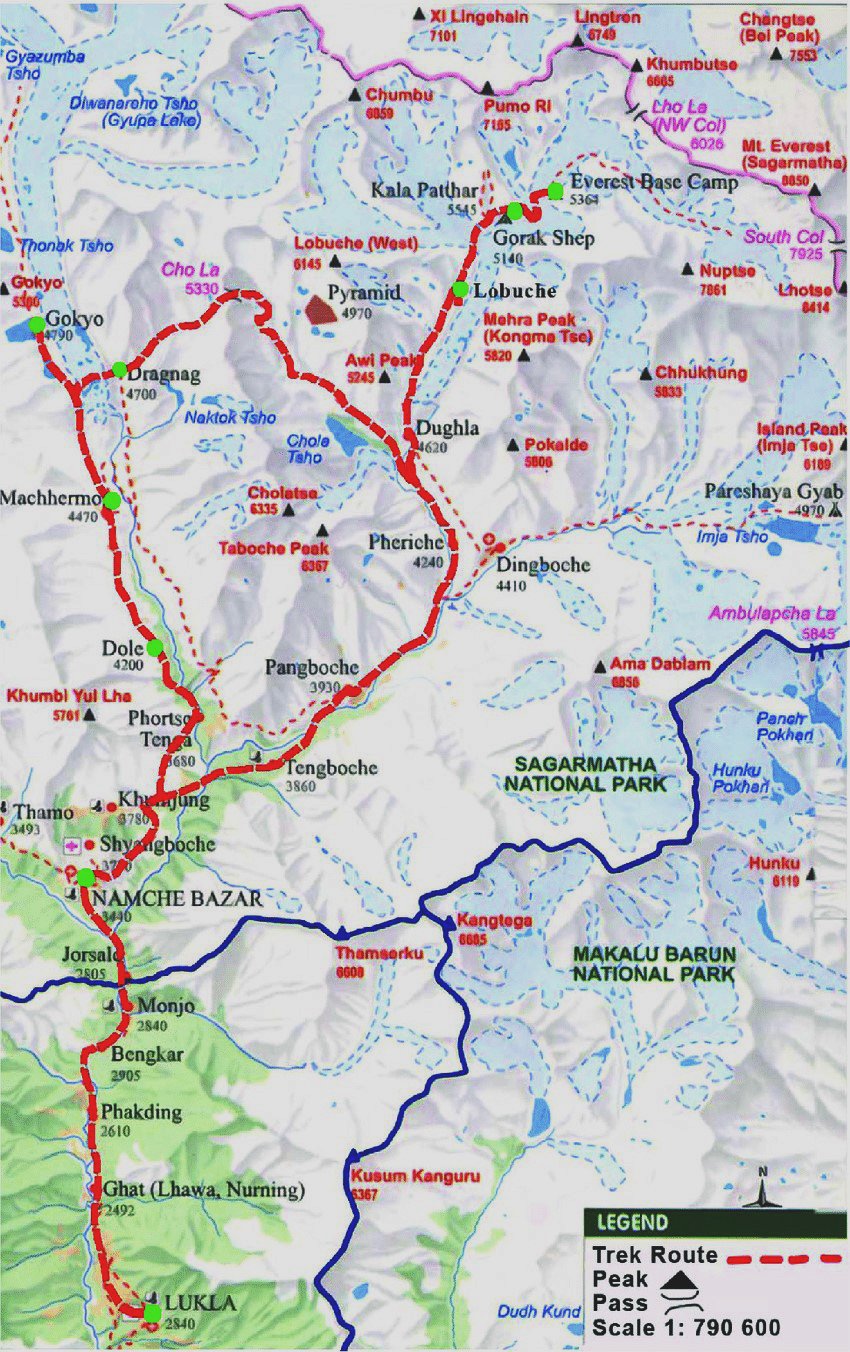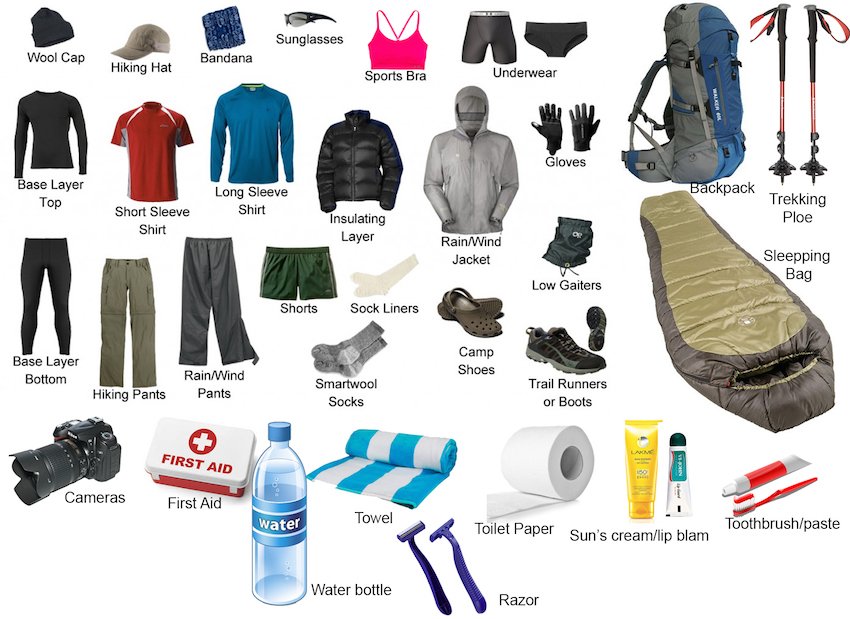Best Time for EBC Trek
When is the best time for EBC trek? Everest Base Camp, nestled amidst the celestial peaks of the Himalayas, beckons adventurers worldwide. But with weather conditions varying dramatically throughout the year, determining the best time for EBC trek becomes paramount. This guide explores the prime trekking seasons in detail, helping you pick the perfect window for your unforgettable Himalayan expedition.
This guide unveils the prime trekking seasons, letting you choose the perfect window for your dream expedition.
Spring (March-May): The Classic Choice
Spring paints the Everest region in vibrant hues, with rhododendrons blooming alongside clear, blue skies. The weather is generally stable and dry, offering ideal trekking conditions:
- Pros: Pleasant temperatures, clear skies, stunning scenery.
- Cons: Peak season with larger crowds, potentially higher prices.
Embrace the Spring Glory, But Be Prepared for Company
Spring is undeniably the most popular time for EBC trekkers. The predictable weather makes it ideal for first-timers and those seeking comfortable hiking conditions. However, this popularity comes with a price tag – expect busier trails and potentially higher accommodation costs.
Autumn (September-November): Unveiling the Majestic Himalayas
As summer bids farewell, autumn transforms the Everest region into a photographer’s paradise. Crisp air and clear skies provide unparalleled views of the majestic peaks:
- Pros: Crystal-clear skies, smaller crowds compared to spring.
- Cons: Colder temperatures, possibility of snowfall at higher altitudes.
Witness Everest’s Majesty in Tranquility (with a Jacket)
Autumn offers a less crowded and potentially more affordable EBC experience. The skies are often crystal clear, allowing for awe-inspiring vistas of Everest and its companions. However, be prepared for colder temperatures and a higher chance of encountering snow at higher elevations. Pack accordingly and relish the serenity of the off-season.
Beyond the Peak Seasons: Shoulder Months
Shoulder months (March, April, May, September, October, November) offer a middle ground:
- Pros: Potentially lower prices, fewer crowds compared to peak seasons.
- Cons: Slightly less predictable weather, possibility of encountering rain or snow at the beginning or end of the seasons.
Shoulder Months: A Budget-Friendly Adventure with a Touch of Adventure
Shoulder months can be a good option for budget-conscious trekkers who don’t mind slightly less predictable weather conditions. Be prepared for potential rain or snow showers, especially towards the beginning or end of these periods.
Choosing Your Perfect EBC Trek Window
The ideal EBC trek window depends on your priorities:
- For predictability and comfort: Spring reigns supreme.
- For smaller crowds and potentially lower costs: Embrace autumn’s serenity.
- For a budget-friendly adventure: Consider shoulder months, but be prepared for variable weather.
Remember:
- Fitness Level: EBC is a challenging trek. Choose a season with milder weather (spring or autumn) if you’re unsure about your fitness.
- Experience: New trekkers might prefer spring or autumn’s predictable weather.
- Budget: Peak seasons are pricier. Shoulder months offer savings but come with slightly less predictable weather.
Plan Your Dream EBC Trek Today!
With this knowledge, you’re well-equipped to choose the perfect time to embark on your life-changing EBC adventure. Start planning your dream trek today and witness the magic of the Himalayas firsthand!
Everest Base Camp Trek: A Once-in-a-Lifetime Adventure
The Everest Base Camp (EBC) trek is one of the most popular trekking destinations in the world. It offers stunning views of the Himalayas, including Mount Everest, the tallest mountain in the world. The trek is challenging but achievable for people with a moderate level of fitness.

The Everest Base Camp Trek Itinerary
The classic EBC trek is a 12-day trek that starts and ends in Lukla, Nepal. Here’s a breakdown of a typical itinerary:
- Days 1-2: Fly from Kathmandu to Lukla and trek to Phakding village (2,650 meters).
- Days 3-4: Trek to Namche Bazaar (3,440 meters), a bustling Sherpa trading town. Acclimatize to the higher altitude.
- Day 5: Hike to Everest View Hotel (3,880 meters) for stunning views of Everest (optional).
- Days 6-7: Trek to Dingboche (4,410 meters) and continue acclimatization.
- Days 8-9: Trek to Lobuche (4,910 meters) and Gorak Shep (5,164 meters).
- Day 10: Hike to Kala Patthar (5,545 meters) for the most spectacular views of Everest.
- Days 11-12: Trek back to Lukla and catch a flight back to Kathmandu.
Difficulty Level
The EBC trek is considered a challenging trek due to the high altitude. The highest point on the trek is Kala Patthar at 5,545 meters. Altitude sickness is a risk for everyone who treks at high altitudes. It’s important to ascend slowly and acclimatize properly to reduce the risk of altitude sickness.
Best Time to Trek
The best time to trek to Everest Base Camp is during the spring (March-May) or autumn (September-November) seasons. These seasons offer clear skies, stable weather, and comfortable temperatures.
Things to Pack for the EBC Trek
- Sturdy hiking boots
- Down jacket
- Warm layers of clothing
- Rain gear
- Sunscreen and sunglasses
- Hat and gloves
- Water bottle and hydration bladder
- Trekking poles (optional)
- First-aid kit
- Personal medications

Permits and Visas
You will need a visa to trek to Everest Base Camp. You can obtain a visa upon arrival in Nepal. You will also need a special trekking permit for the Everest region. Your trekking company can help you obtain the necessary permits.
EBC Trek Cost
The cost of the EBC trek can vary depending on the operator, the time of year, and the level of service. Generally, you can expect to pay around $2,000-$3,000 for a guided EBC trek. This cost typically includes all accommodation, meals, transportation, and permits.
Tips for Trekking to Everest Base Camp
- Train for the trek: The EBC trek is challenging, so it’s important to be in good physical condition.
- Acclimatize properly: Altitude sickness is a serious risk. Ascend slowly and take rest days to allow your body to adjust to the high altitude.
- Drink plenty of water: Dehydration can worsen altitude sickness. Aim to drink 3-4 liters of water per day.
- Be prepared for the weather: The weather in the Himalayas can change quickly. Be sure to pack for all conditions.
- Hire a guide: A qualified guide can help you navigate the trails, ensure your safety, and provide valuable information about the region.
- Enjoy the experience: The EBC trek is an incredible adventure. Take your time, soak in the views, and enjoy the experience!
EBC Permits: Your Gateway to Everest Base Camp
Trekking to Everest Base Camp (EBC) requires obtaining a couple of permits. Here’s a breakdown of what you’ll need:
1. Khumbu Rural Municipality Permit:
- This permit allows entry into the Khumbu region, where Everest Base Camp lies.
- Cost: NPR 2,000 (around $20 USD) for the first four weeks, NPR 2,500 (around $25 USD) thereafter.
- Validity: Valid for the duration of your trek in the Khumbu region.
- Where to obtain:
- Recommended: Nepal Tourism Board (NTB) office in Kathmandu.
- Alternatively: Sagarmatha National Park entrance gate in Monjo village (be prepared to wait during peak season).
2. Sagarmatha National Park Entry Permit:
- This permit grants access to Sagarmatha National Park, which encompasses Everest Base Camp.
- Cost:
- Foreigners: NPR 3,000 (around $30 USD)
- SAARC nationals (India, Bhutan etc.): NPR 1,500 (around $15 USD)
- Validity: Valid for the duration of your stay in Sagarmatha National Park.
- Where to obtain:
- Along with the Khumbu Rural Municipality Permit at the NTB office in Kathmandu.
- You can also purchase it at the Monjo entrance gate.
Additional Notes:
- You will need your passport with a valid visa and passport-sized photographs to obtain these permits.
- Some trekking companies might include obtaining permits in their service package.
- Consider purchasing Trekkers’ Information Management System (TIMS) registration, which helps track trekkers and improve safety. You can obtain TIMS registration along with the permits at the NTB office.
- Fees are generally payable in Nepalese Rupee (NPR).
Remember: Obtaining permits is crucial for a responsible and legal trek to Everest Base Camp. Plan accordingly and factor in permit costs while budgeting for your adventure.

Conclusion: Conquering Everest Base Camp – A Timeless Adventure
The Himalayas hold a timeless allure, and conquering Everest Base Camp is an experience that will stay with you forever. By understanding the best time for EBC trek based on your preferences, you can ensure your adventure aligns perfectly with your expectations.
Whether you crave the warmth and vibrancy of spring, the crisp serenity of autumn, or a budget-friendly shoulder month escapade, the EBC trek awaits. So, lace up your boots, choose your perfect season, and embark on a journey that will leave you breathless – quite literally, at times!
Remember, the best time for an EBC trek is the time that best suits you. Do your research, consider the factors mentioned above, and choose the window that aligns with your vision for this once-in-a-lifetime experience.
Happy trekking!
FAQ
General:
-
What is the EBC trek? The EBC trek is a challenging but rewarding hike that leads you to Everest Base Camp, nestled amidst the Himalayas.
-
How difficult is the EBC trek? The trek is considered challenging due to high altitude. While technical skills aren’t required, good fitness and proper acclimatization are crucial.
-
What’s the best time to trek EBC? Spring (March-May) and autumn (September-November) offer clear skies, stable weather, and comfortable temperatures.
Permits and Cost:
-
What permits do I need for the EBC trek? You’ll need two permits:
- Khumbu Rural Municipality Permit for entry into the Khumbu region (around $20-$25 USD)
- Sagarmatha National Park Entry Permit for access to the park (around $30 USD for foreigners).
-
How much does the EBC trek cost? Costs vary depending on the operator, season, and service level. Generally, expect $2,000-$3,000 for a guided trek, including accommodation, meals, transportation, and permits.
Packing and Training:
-
What should I pack for the EBC trek? Sturdy hiking boots, warm layers, down jacket, rain gear, sun protection, hat & gloves, water bottle/hydration bladder, trekking poles (optional), first-aid kit, personal medications.
-
How should I train for the EBC trek? Regular exercise focusing on cardio and building leg strength is essential. Simulating altitude with stair climbing can also help.
Additional Tips:
- Hire a guide? While not mandatory, a qualified guide can enhance safety, navigate trails, and provide valuable knowledge about the region.
- Acclimatization: Ascend slowly and take rest days to allow your body to adjust to the high altitude and reduce the risk of altitude sickness.
- Hydration: Drink plenty of water (3-4 liters daily) to stay hydrated and combat altitude sickness.
- Be prepared for the weather: Mountain weather can change rapidly. Pack for various conditions.
- Enjoy the experience! The EBC trek is an unforgettable adventure. Savor the views, embrace the challenge, and create lasting memories.

